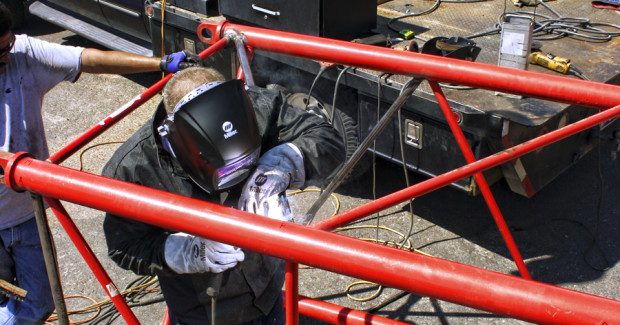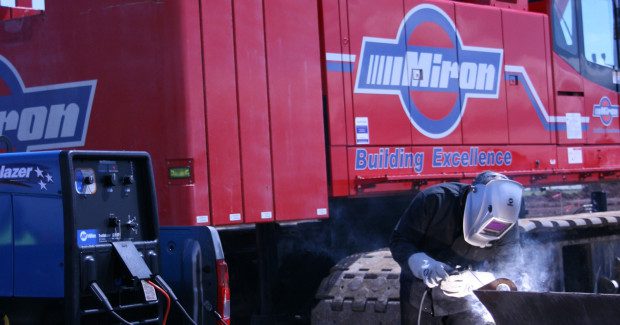How Electronic Fuel Injection Technology Improves Efficiency of Engine-Driven Welding Power Sources
As contractors and welders continually look for ways to reduce welding costs and be more efficient, things as simple as engine choice can make quite a difference.
Posted: February 14, 2014
New technologies in engine-driven welding power sources pay tribute to the old saying “It takes money to make money.” When you are looking at equipment like an engine-driven welding power source, consider looking beyond the purchase price tag to see what kind of return on your investment you can get from this equipment. The total cost of ownership — not the up-front purchase price — may translate to more profitability over time.
Electronic Fuel Injection (EFI) is one of those considerations. It has been used for decades and is standard in many cars, but it’s fairly new to the smaller engines used in gasoline-powered engine-driven welding power sources. Incorporating EFI technology results in reduced emissions similar to those seen in the automotive industry, and it provides numerous other benefits in welding and field applications.
EFI technology uses a computer to sense how much air is going into the intake manifold and matches the correct amount of fuel to ensure the most efficient use of fuel. Essentially, this means EFI capability optimizes the air/fuel ratio at all engine speeds and load demands. When the welding needs are larger, the engine will have to use more fuel to meet the demand. Conversely, when there is a lower load demand, the engine will use less fuel to meet the demand. This results in lower operational costs, fewer emissions, longer runtimes and better performance in certain environments for gas engines when compared to carbureted engines.
http://youtu.be/HtBHQOaIbhE
A review of the benefits of the Bobcat 250 EFI and Trailblazer 302 EFI engine-driven welding generators.
To get an idea of the potential payoff in choosing a welder/generator with EFI technology, consider that the option may cost an extra $800 when compared to a carbureted model, but the average user can save more than $1,200 a year in fuel costs alone with an EFI-equipped machine from the improved fuel economy and extended runtimes that result. (Fuel savings based on a typical usage profile of welding at 150 amps 40 percent of the time; 20 amp generator load 30 percent of the time; and idle without a load 30 percent of the time.) That fuel efficiency in just the first year can pay for the cost difference to invest in EFI. Additionally, welder/generators with EFI can run up to five hours longer on a single tank of fuel than a machine without it.
Worker downtime decreases when fewer gas fill-ups are necessary, adding to the return on investment with EFI. A machine that uses less fuel means more time working and fewer trips to the gas station. Workers on the jobsite can spend more time on other activities that produce the company’s billable goods, and this can potentially provide significant returns on the extra dollars spent for the EFI technology.
Gasoline engines often work better in certain conditions. In colder temperatures a carbureted engine requires a choke to get it started. This can lead to flooding the engine, which can significantly add to unnecessary downtime. At higher altitudes, a carburetor may need to be adjusted by adding an electronic fuel pump to the machine. EFI technology means reliable operation with changes in altitude, and fast all-weather starts in the colder climates.
Reduced fuel consumption, along with reliable starting and engine operation in different conditions, all add up to a technology upgrade that can pay for itself within a matter of months.
In addition to EFI, other technology options can help make engine-driven welding power sources more fuel efficient and quiet. For example, two technologies from Miller — Auto-Speed and Excel power — help improve fuel efficiency and also help to significantly reduce noise levels of the machine. The Excel power option allows workers to use power tools, lights and other tools at low engine rpm (idle speeds) rather than at full engine speeds, making for a much quieter jobsite while also conserving fuel.
Decreasing the noise produced by the engine-driven welder offers two beneficial aspects. The first is a better work environment for the welding operators themselves. A quieter machine makes for a more comfortable environment and helps improve jobsite safety, since it makes it easier for workers to communicate with each other and to hear what’s happening around them.
The second benefit to a quieter machine is the reduced potential for running afoul of noise permit or noise restriction issues. This is especially key when the jobsite is in a noise-sensitive area, such as a residential neighborhood or near a hospital. Having quieter machines often means being able to work earlier and later in those areas, without the worry of violating noise restrictions. This can help shorten overall project timelines and make contractors more competitive in bids, as well as contribute to being a “good neighbor” at that work site.
Contractors and welding operators understandably are mindful of the up-front costs when they purchase equipment. However, the bottom line is that investing in an engine-driven welding power source with technology advancements can dramatically increase the return on investment, resulting in upgrades that pay for themselves in a short time.

















